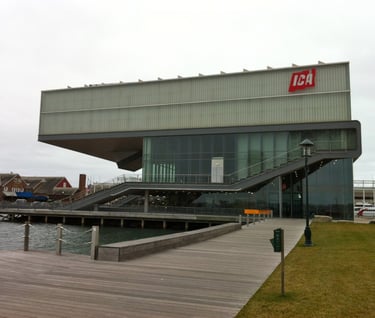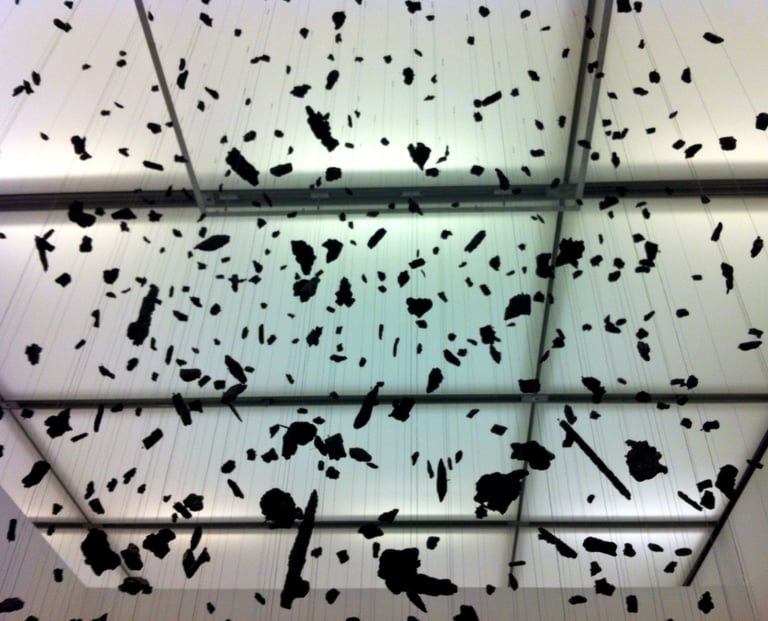Boston ICA Permanent Collection: Tension on Display
Jessica Cook
2/5/2013


Situated on the chilly and austere Boston Harbor waterfront, the Institute of Contemporary (ICA) stands in stark contrast to its surroundings. The bulky building stands aloof against the backdrop of the commanding New England sea that spreads out behind it. The ICA stands confidently, asserting its right to exist as a powerful (man-made) entity, against the tumultuous ocean that foams and sprays over its deck. These two powerful entities seem to paradoxically compliment one another, each relying on the other for it’s very quintessence. The harsh whiteness of the building is reflected in the whitecaps of the harbor, while the museum’s huge glass windows reflect the deep, brooding cobalt of the stormy sea. This same powerful relationship continues in the interior of the building within the confines of a single room that holds Tara Donovan’s Untitled (Pins) and Cornelia Parker’s Hanging Fire (Suspected Arson).
In Parker’s Hanging Fire (Suspected Arson), Parker uses pieces of burnt wood taken from a building destroyed by fire, where arson was the suspected cause of the blaze. The blackened wood pieces seem to explode in all directions, yet are paradoxically caught and held motionless within a rectangular column of air. The rigid arrangement of the hanging charcoal produces a clear linearity within the piece, creating the illusion that the air itself has become a solid building material that links the wood together in order to reconstruct the formerly dematerialized building. Thus, the air within the column becomes an integral part of the work itself: the transparent walls it forms rigidly constrain the volatile charred wood, turning destruction into an arbitrarily arranged edifice reconstruction. The piece exists as a series of inherent tensions: the explosion struggles to free the wood from the grasp of immobility, the heavy charcoal pieces float against the will of gravity, and the dense black wood asserts its existence against the transparent air. Thus, Hanging Wire thrives on intrinsic contradictions even at the level of the materials. The piece would be serene, but for the darker connotation brought about by the fact that the wood is the actual material from a supposed arson attack. Given this knowledge, the piece represents a Minimalist reconstruction of the annihilated building itself, fundamentally equivalent in type of material and shape, yet radically different in nature, scale, and appearance.


In contrast to the ostensible weightlessness of Hanging Fire (Suspected Arson), Donovan’s Untitled (Pins) sits firmly in the floor, challenging the earthy black of the burnt wood with its immense, ostentatious metallic form. The cube sparkles, catching the light from the gallery skylights and magnifying it to a dazzling brightness. Donovan used “thousands of metal straight pins” to mold the cube, which exists completely “without magnetization or any adhesives” (ICA). Instead, the cube relies on the force of gravity to keep the innumerable small pins in the form of a immense geometric structure. Donovan creates the sculpture in the shape of a cube (a reference to Minimalism), yet pulls away from Minimalist paradigms by creating her cube using a multitude of minuscule units that deliberately lack premeditated order or repeated regularity of orientation. Thus, the sculpture fundamentally becomes a struggle between the molded adhesion of the straight pins that create the form, and hypothetical forces that threaten to shatter the cube into thousands of tiny sparkling pieces.


Tara Donovan, Untitled (Pins), 2003. Size #17 straight pins. 42 x 42 x 42 inches (106.7 x 106.7 x 106.7 cm). Promised gift of Barbara Lee
Both pieces reflect an inherent tension that seems intrinsic to the existence of the ICA itself—a constant struggle for existence and recognition between two conflicting yet inexplicably dependent forces.
